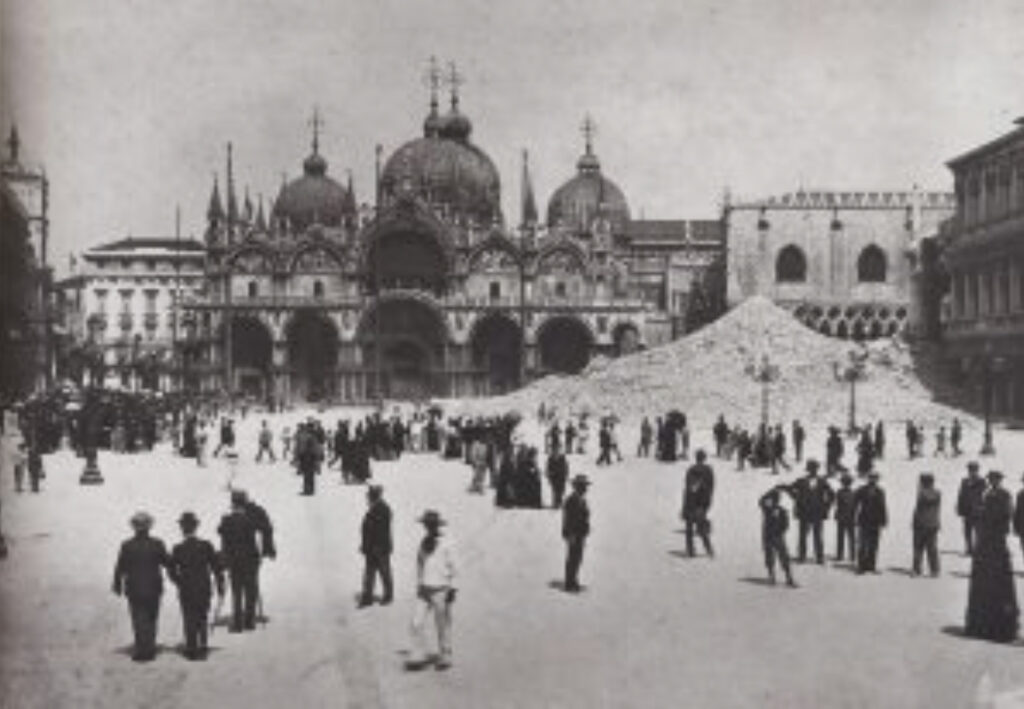The Campanile di San Marco is one of the symbols of Venice. The Venetians affectionately call him “El parón de casa”, the landlord. 98.6 meters high, it is one of the tallest bell towers in Italy. It stands majestically in San Marco square in front of the basilica. Simple in shape, it consists of a grooved block of bricks, each side 12 meters wide and about 50 meters high, above which is the arched bell cell. The bell cell is in turn surmounted by a cube, on whose faces are alternately depicted the winged lions and the female figures of Venice (Justice). The tower is completed by a pyramidal spire, on top of which the golden statue of the archangel Gabriel is placed as a wind vane. From the side facing the basilica, the base of the building is enhanced by the “Loggetta del Sansovino”.
The construction originally served as a watchtower and lighthouse and began in the 9th century during the Dogado of Pietro Tribuno on drawings of Roman origin. The construction was remodeled in the XII century, during the Dogado of Domenico Morosini, and again in the XIV century. After being damaged in 1489 by lightning and severely hit by an earthquake in 1511, the renovation and remaking works began immediately. The tower was consolidated, the bell cell was built, the sculptures depicting the symbols of Venice were placed, the pyramidal bronze spire with the statue of the archangel Gabriel was placed. The bell tower took on its final appearance between 1511 and 1514. Baldassare Longhena carried out a renovation in 1653, other works followed due to lightning. In 1776 the bell tower was equipped with a lightning rod and in 1820 the statue of the archangel was replaced with a new one by Luigi Zandomeneghi.
On the morning of Monday 14 July 1902 at 9.47 am the bell tower suddenly collapsed due to imprudent masonry work. The damage caused is not irreparable: the “pietra del bando” (banishing stone) at the corner of the Basilica prevented the collapse of the corner column and saved the basilica. The “Loggetta” was instead buried under the boulders. The news of the collapse spread all over the world: the City Council decided that the bell tower had to rise identical to the collapsed one.
The foundation stone was placed on April 25, 1903, nine years later, in 1912, on the same day as San Marco, the new bell tower was inaugurated. The reconstruction faithfully copies its external appearance and for greater solidity and static safety is carried out according to the most rigorous construction techniques laws. During the collapse of the bell tower only the main bell was saved. The remains of the 4 old bells were remelted and again made in a foundry built specifically on the island of Sant’Elena.
The new bell concert is made up of 5 bells. The largest is the “Marangona” (Ø 1,800 m – 3625 kg) which announced the beginning and end of the working hours of the “marangoni”, the carpenters of the Arsenale and the sessions of the Major Council. Follows the “Nona” (Ø 1,560 m – 2556 kg), which marked and still marks midday. Then the “Trottiera” (Ø 1,385 m – 1807 kg) which gave the Venetian nobles and aristocrats the signal to participate in the meetings of the Major Council. The fourth bell called “Pregadi” (Ø 1,290 m – 1366 kg) announced the meetings of the Senate, whose members were called “pregadi”. The minor of the bells called “Renghiera” (Ø 1,160 m – 1011 kg) heralded the executions. The “plenum”, the sound of the 5 bells simultaneously, took place and happens only for the major religious solemnities and anniversaries.






